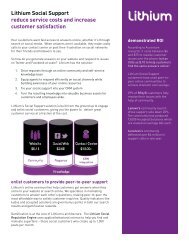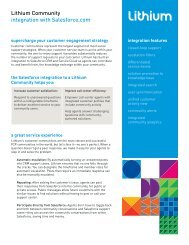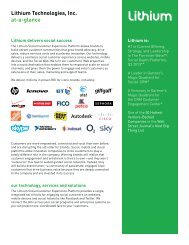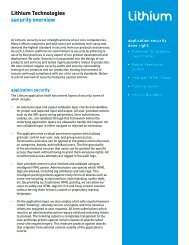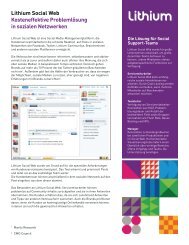Online Communities—the Heart of Social Strategy - Lithium
Online Communities—the Heart of Social Strategy - Lithium
Online Communities—the Heart of Social Strategy - Lithium
You also want an ePaper? Increase the reach of your titles
YUMPU automatically turns print PDFs into web optimized ePapers that Google loves.
online community:<br />
the heart <strong>of</strong> social strategy
contents<br />
1 intro<br />
2 why owned media matters<br />
3 beyond connection: social customer engagement and enlistment<br />
4 online community fundamentals<br />
5 how online communities drive business goals<br />
7 conclusion<br />
we help companies unlock the passion <strong>of</strong> their customers.<br />
The <strong>Lithium</strong> <strong>Social</strong> Customer Suite allows brands to build vibrant customer communities that:<br />
lithium.com | © 2012 <strong>Lithium</strong> Technologies, Inc. All Rights Reserved<br />
share this whitepaper<br />
2
intro<br />
With 1.43 billion people predicted to be social network<br />
users by the close <strong>of</strong> 2012, 1 mastering the social media<br />
marketplace and implementing online community<br />
strategy is fast becoming an imperative. But as our social<br />
customers leap from network to platform to app it becomes<br />
increasingly difficult for us to differentiate ourselves,<br />
measure success and show value. Fans and followers are<br />
strong channel performance indicators—they should be<br />
tracked—but most brands have figured out that they in<br />
themselves don’t necessarily translate to business value.<br />
While most <strong>of</strong> us are keen to develop our social prowess,<br />
many still struggle with fundamental questions about how<br />
to support business objectives and measure social media<br />
success from our investments in the constantly emerging<br />
social media landscape.<br />
share this whitepaper<br />
In the face <strong>of</strong> all the new complexity social media brings,<br />
it becomes increasingly important that we are deliberate<br />
about the social customer experiences we deliver or we<br />
run the risk <strong>of</strong> putting our social customers through<br />
fractured and disjointed brand experiences without purpose.<br />
Likewise, it becomes important that we deliver social<br />
customer experiences through on-domain, owned hubs<br />
where we not only control the experience, but we own all the<br />
valuable social customer interaction data they produce. That<br />
owned, on-domain social customer experience solution is<br />
the online community.<br />
1
why owned media<br />
matters<br />
Unlike Facebook pages, online communities are customer<br />
networks we own. They can be fully branded and the way<br />
social customers experience them is entirely up to us.<br />
Remember how Facebook decided to put all brand pages<br />
into the Timeline format? Suddenly, the way our customers<br />
experienced our brand through the social network was turned<br />
on its head. That’s the problem with social media that we<br />
don’t own—its value is constantly at risk.<br />
Yes, it’s important that we show up where our customers<br />
congregate. They should be able to find us and strike up a<br />
dialog with us on Facebook and Twitter. But we’ll always be<br />
severely limited when we engage with customers through<br />
public social networks. Since we have little control over the<br />
way the way our customers experience our brand on sites like<br />
Facebook and Pinterest, differentiating ourselves becomes<br />
problematic. Since we don’t own the social customer<br />
interaction data that streams through Twitter, we can’t<br />
capture it, analyze it, or derive any meaningful insight from it.<br />
share this whitepaper<br />
Unless, at the heart <strong>of</strong> our social strategy lies an online<br />
community. An online community is a central, flexible social<br />
customer experience solution that integrates easily with <strong>of</strong>fdomain<br />
networks. Importantly, we own all the user-generated<br />
content it produces. We can harvest it, analyze it, and use it to<br />
inform the business. And we can continue to deliver the right<br />
social customer experiences for our brand no matter how<br />
the social media environment changes through simple online<br />
community management.<br />
<strong>Online</strong> communities are owned, on-domain<br />
hubs where we can deliver social customer<br />
experiences that engage and enlist customers<br />
to help drive real business outcomes.<br />
2
eyond connection:<br />
social customer<br />
engagement and<br />
enlistment<br />
So, what are the right social customer experiences? They are<br />
those that go far beyond simply inviting customers to make<br />
a connection with us. Simple connections through social<br />
networks have little value in and <strong>of</strong> themselves when we<br />
can expect only 2% <strong>of</strong> those who like us on Facebook to ever<br />
return to the page. 2 In order to derive real business value<br />
from our social and online community strategy, the onus is on<br />
us to do far more than settle for a single, fleeting impression.<br />
In order for social customer experiences to bring us real<br />
business value, they must engage and enlist, and this is<br />
precisely what an online community solution is designed to<br />
do. <strong>Online</strong> communities are places where brands can <strong>of</strong>fer<br />
engaging social customer experiences—not just opportunities<br />
to like or follow—but to participate, to interact with other<br />
social customers like themselves, to solve problems, share<br />
ideas, and trumpet their enthusiasm for the brands and<br />
products they love.<br />
When social customers become engaged in any <strong>of</strong> these<br />
behaviors, we are on our way to driving real business<br />
outcomes from social media. Engaged social customers<br />
tell their friends about our products and help drive word <strong>of</strong><br />
mouth marketing. Enlisted social customers contribute to<br />
our forums and produce huge quantities <strong>of</strong> user-generatedcontent<br />
(UGC) that boosts search results. Deeply engaged<br />
and enlisted customers—our brand superfans—contribute<br />
support solutions that benefit everyone and reduce calls to<br />
the call center.<br />
Only engaged and enlisted<br />
share this whitepaper<br />
customers can help us to drive our<br />
business goals. <strong>Online</strong> communities<br />
give us the greatest opportunity to<br />
engage and enlist.<br />
3
online community<br />
fundamentals<br />
An online community at its most basic level is a collection <strong>of</strong><br />
social engagement and enlistment apps where we can create<br />
personalized social experiences, manage and moderate<br />
conversation, reach a global audience, and drive website<br />
traffic with SEO.<br />
Every successful community solution has four basic<br />
ingredients if expected to engage and enlist social customers<br />
to behave in ways that benefit the community: Utility,<br />
Relevance, Health, and Reach.<br />
Community Utility<br />
Great communities are useful—first and always. They should<br />
be places where human interaction is easy, where social<br />
customers become easily engaged because they can quickly<br />
find what they need and collaborate to solve problems. They<br />
are principally platforms for social customers to collaborate<br />
with each other and the brand, <strong>of</strong>fering things like how-to<br />
content, tips and tricks. They should be places where the<br />
most useful content can be rated, ranked, tagged, curated and<br />
organized to facilitate an easy search-and-find.<br />
Community Relevance<br />
Like all social customer experiences today, community<br />
experiences must be—and stay—relevant. Communities<br />
that <strong>of</strong>fer personalized dashboards, customizable content<br />
and personalized control over the community experience<br />
are better aligned with member needs and interests and<br />
therefore more deeply engaging. Communities that strive<br />
to remain fresh and relevant to their social customers enjoy<br />
higher participation rates—and better community health.<br />
Community Health<br />
Healthy online customer<br />
communities do a number <strong>of</strong> things<br />
right. More than featuring strong<br />
traffic, membership growth, fresh<br />
and relevant content, they are<br />
also responsive, interactive and<br />
lively. The healthiest communities<br />
put a strong focus on these last<br />
three components, <strong>of</strong>ten fueling<br />
interactivity with gamification—the<br />
introduction <strong>of</strong> gaming dynamics into<br />
the community experience in order<br />
to motivate greater participation and<br />
contribution.<br />
share this whitepaper<br />
community social<br />
engagement apps<br />
forums<br />
blogs<br />
ideas<br />
contests<br />
q&a<br />
Community Reach<br />
Today, brands are expected to have enormous reach if we<br />
want our social customer engagement and enlistment<br />
strategies to succeed. By starting with community first and<br />
then extending that out to the greater web with smart social<br />
integrations, we not only show up where our customers<br />
hang out, but we bring all the benefits <strong>of</strong> community with us.<br />
Community experiences like peer-to-peer support, a place<br />
to give feedback and testimonials about brand experiences,<br />
to achieve rank and reputation, enter contests, exchange and<br />
vote on ideas—all designed to engage and enlist our social<br />
customers in helping to drive our business goals.<br />
For more on community health, download The <strong>Lithium</strong><br />
Community Health Index – a measure <strong>of</strong> community traffic,<br />
members, content, responsiveness, interaction and liveliness.<br />
ratings & reviews<br />
surveys & polls<br />
videos & photos<br />
knowledge bases<br />
4
how online<br />
communities drive<br />
business goals<br />
Exactly what we engage and enlist our social customers to<br />
do in an online community depends on the business goals<br />
behind our social strategy. There are four distinct types <strong>of</strong><br />
online customer communities, each with a different strategic<br />
function that drives a unique set <strong>of</strong> specific business values.<br />
<strong>Social</strong> Support communities enable customers to help each<br />
other more quickly and easily online. Their business value lies<br />
in how many service calls the community deflects and by how<br />
well customers rate their serviced experiences.<br />
<strong>Social</strong> Marketing communities enable customers to share<br />
their passion for the brand and its products. Their business<br />
value lies in how the community improves SEO and Word <strong>of</strong><br />
Mouth Marketing (WOMM).<br />
<strong>Social</strong> Commerce communities enable customers to interact<br />
with peers and customer experts for advice and assistance<br />
throughout the purchase cycle. Their business value lies in<br />
how well they increase sales.<br />
Ideation Communities enable companies to collect feedback<br />
on existing products and ideas for new ones. Their business<br />
value lies in how much they accelerate innovation and reduce<br />
the cost <strong>of</strong> bringing new products to market.<br />
share this whitepaper<br />
It’s important that we keep the strategic function <strong>of</strong> our<br />
community in mind when we analyze success. Communities<br />
can, and <strong>of</strong>ten do, perform more than one strategic function.<br />
Those that do should have separate engagement and<br />
enlistment strategies for each function, separate KPIs and<br />
business outcomes against which to measure success.<br />
The following table illustrates how to define online<br />
communities by their strategic function, which KPIs are<br />
relevant and what business value can be derived from each<br />
community type.<br />
5
share this whitepaper<br />
community type strategic function KPIs business value<br />
social support<br />
social marketing<br />
social commerce<br />
ideation<br />
Enable customers to support each<br />
other online<br />
Motivate customers to share their<br />
passion for the brand and products<br />
Connect potential customers to<br />
peers for reviews and product advice<br />
Motivate social customers to<br />
contribute product ideas<br />
• # creators/critics in support community<br />
• # community questions<br />
• # questions answered by community<br />
• # solutions accepted by community<br />
• cost per solution<br />
• time to answer<br />
• positive ratings <strong>of</strong> content/answers<br />
• Community traffic<br />
• SEO performance<br />
• Superfans identified/content created<br />
• Interactions per post<br />
• Content submitted/shared<br />
• Content performance<br />
• Contest participation<br />
• Pages shared<br />
• Promotional <strong>of</strong>fers accepted<br />
• Conversion<br />
• Conversion rates<br />
• Order size<br />
• Returns<br />
• Repeat customers<br />
• Ideas generated<br />
• # creators/critics<br />
• Rating <strong>of</strong> ideas<br />
• # votes/ideas<br />
• # actionable ideas<br />
↑ customer<br />
satisfaction<br />
↑ positive<br />
word-<strong>of</strong>-mouth<br />
↑ revenue<br />
↓ cost <strong>of</strong> support<br />
↑ brand awareness<br />
↑ word-<strong>of</strong>-mouth<br />
marketing (WOMM)<br />
↑ product<br />
consideration<br />
↑ customer<br />
lifetime value<br />
↓ time to market<br />
↓ cost <strong>of</strong> innovation<br />
↑ product adoption/<br />
satisfaction<br />
6
conclusion<br />
In the complex social media landscape <strong>of</strong> today, it becomes<br />
increasingly important that we deliver social customer<br />
experiences that engage and enlist if we want our social<br />
customers to help us to drive real business outcomes. We<br />
must be deliberate about our social customer experience<br />
<strong>of</strong>fering and the place we have the greatest control over that<br />
<strong>of</strong>fering is through an online community.<br />
<strong>Online</strong> communities <strong>of</strong>fer our social customers the types <strong>of</strong><br />
experiences they want, crave, even demand—peer-to-peer<br />
engagement, personalized social experiences, a place to<br />
share their enthusiasm for the brands and products they love,<br />
and lots <strong>of</strong> reward and recognition when they do. Best <strong>of</strong> all,<br />
resources<br />
1 Facebook Helps Get One in Five People Worldwide <strong>Social</strong>izing on <strong>Online</strong><br />
Networks, eMarketer, 2012<br />
2 Study: Facebook Timeline Doesn’t Affect Engagement, AllFacebook, 2012<br />
share this whitepaper<br />
<strong>Lithium</strong> social solutions helps the world’s most iconic brands to build brand nations—vibrant online communities <strong>of</strong> passionate social customers.<br />
<strong>Lithium</strong> helps top brands such as AT&T, Sephora, Univision, and PayPal build active online communities that turn customer passion into social<br />
media marketing ROI. For more information on how to create lasting competitive advantage with the social customer experience,<br />
visit lithium.com, or connect with us on Twitter, Facebook and our own brand nation – the Lithosphere.<br />
lithium.com | © 2012 <strong>Lithium</strong> Technologies, Inc. All Rights Reserved<br />
online communities are on-domain, owned hubs that <strong>of</strong>fer<br />
up a wealth <strong>of</strong> valuable social customer interaction data that<br />
would otherwise be lost to us if we were to remain dependent<br />
upon public social networks like Facebook for the bulk <strong>of</strong> our<br />
social <strong>of</strong>fering.<br />
<strong>Online</strong> community solutions sit perfectly at the heart <strong>of</strong><br />
social strategy because they are central to our engagement<br />
and enlistment strategies, and engaging and enlisting our<br />
social customers to behave in ways that drive real business<br />
outcomes are what make our social strategies successful.<br />
7



